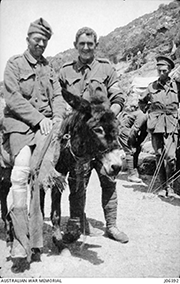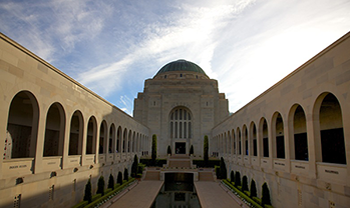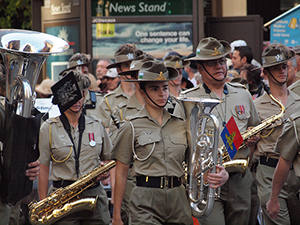|
The Anzac spirit refers to the great courage, bravery and determination shown by the soldiers fighting at Gallipoli. Apart from the strong chance of being wounded or killed in the fighting, they faced many other hardships including:
They faced difficult conditions and many hardships with a sense of humour, mateship and loyalty. One of the most well-known of Anzac heroes was John Simpson. What does his story tell us about the nature of many of the soldiers at Gallipoli? Explore other stories from Australia’s First World War soldiers.
|
 Private John Simpson assisting a wounded British soldier ©Australian War Memorial, public domain |
Symbols are pictures, objects or acts in our culture and environment that represent something else. Symbols are an easy way for us to understand or express an idea.
Here are some symbols of remembrance in Australia. Do you recognise what they are? Can you think of any other symbols that might be seen on Anzac Day or Remembrance Day?
|
|
Use Office 365 or Google Apps to create a shared class presentation. Small groups will each research and produce a slide for one Anzac symbol before bringing them together to form your class presentation. Each slide should include:
|

The Australian War Memorial, Canberra. Public domain.
War memorials help us to remember all the people who have served and died in war. A memorial can be a plaque, an object, a building or even a place. They can be found in the largest cities and the smallest country towns across Australia.
The Australian War Memorial was completed in 1941. Its purpose is to honour Australians who have lost their lives in various wars. The Memorial contains historical artefacts to help us remember and understand the Australian experience of war.
Part of the Australian War Memorial’s role is to commemorate significant historical events, such as Anzac Day and Remembrance Day.

The Register of War Memorials in New South Wales or the Remember Them app contains information on over 3000 memorials. Find one close to your school and complete the research questions (.docx 533kB).

Create a poster that interprets and explains all the features of a local war memorial. You may use a program such as Explain everything, Glogster or Canva or create a paper version.
|
Every year we commemorate the great sacrifice and service of all soldiers by participating in formal ceremonies and marches throughout the country and overseas. In the 1960s and 1970s attendance at Anzac Day parades was falling and few people went to Turkey. In recent years, however the Dawn Service at Gallipoli has become a popular pilgrimage for Australians and New Zealanders wishing to show their respect for the fallen. Anzac Day marches are also now attended by tens of thousands of people across the country. In fact, in many places they are becoming more popular. Now that all Australians who served in the First World War have died, and there are fewer and fewer veterans of the Second World War, questions are being asked about what these marches will look like in the future. Should the relatives of deceased Turkish soldiers be allowed to march? |
 Anzac Day march in Sydney, 2013. |
-
Who marches?
-
Why do they march?
-
Who is in the audience?
-
Why do they come to the march?
-
What ANZAC symbols can you see?
-
Predict the atmosphere - how are people feeling?
-
What are people wearing in the parade? Why?
-
What is the significance of the bands and the music?
-
Why do the crowd wave flags?
-
How is the Anzac spirit represented?
-
Why are crowds increasing?








